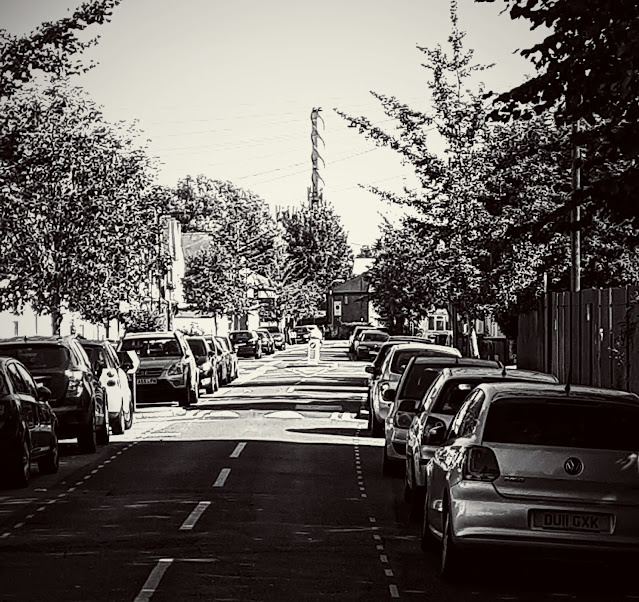Cycling back to Edmonton and its incinerator
 |
| Phallic and menacing: the beast in the background (photo by the author) |
Edmonton never stood a chance against Cambridge. Not as a vis-à-vis
encounter. After all one is a ward and the other
one a city. The imbalance was shown more in the way of how campaigns played out
in each area and how effective they were.
It always feels strange going back to Edmonton. As
soon as I cycle past White Hart Lane (or Tottenham Hotspur Stadium as it’s
called now) and enter N18 territory a sense of nostalgia overcomes me.
I lived in this neighbourhood of Enfield for more
than twenty years (my abode was in N9). Whilst some people have long had
reservations about this part of north London (diverse, multicultural,
working-class), I’ve got a soft spot for it. I was one of Edmonton’s residents,
one of the many immigrants shopping in the Green, having my hair done (when I
had long hair) at Victoria’s on Fore Street and buying jollof rice and chicken
from Rebecca’s Kitchen.
But when I went back recently in order to deliver
some cycling training at a primary school off Fore Street, there was another
thought doing the rounds in my head. A Facebook friend of mine had just sent me
a link a few days before to a BBC Sounds podcast. The programme – called “Power to Which People?” – focused on the
planned expansion of the Edmonton incinerator, the largest of its type in Britain
and a bone of contention for environmentalists and community groups for many
years.
I had already moved to Edmonton and my son was still
a small baby when I first spotted the monster in the distance. It stood erect, a
carbon dioxide emission machine coughing up smoke continuously. I still remember
that in those years we had someone from Greenpeace or similar outfit camp up in
our fifteenth-floor flat for a whole day, monitoring the incinerator.
Since the news was announced, there has been a
campaign to stop the extension of the incinerator. “Power to Which People?” touched on that. A village in Cambridge
faced a similar issue. A developer wanted to build an incinerator in
Waterbeach. Had they gone ahead with their plans, the new structure would have
been taller than Ely Cathedral and visible for miles around.
The council stopped the project on its planning
stages arguing that it would have a detrimental impact on the landscape and
nearby historic buildings.
Sadly, Edmonton is not Cambridge. It is an urban,
heavily populated and deprived part of the UK. There are historic buildings, however.
Salisbury House, on the northern side of the A10, is a Grade II listed late 16th
century three-storey building. The poet John Keats lived on Church Street with
his siblings and grandmother. A blue plaque links his presence to the area. But
instead of cathedrals, there are chicken shops, kebab joints and Poundstretchers.
Edmonton is already at the receiving end of a
pollution onslaught. It’s surrounded by the North Circular to the west, the
aforementioned A10 to the north (officially called Cambridge Road. Oh, the
irony!) and Southbury Road (already Ponders End territory) to the east. To the
south, Mollison Avenue completes what I used to call when I lived there “the
square of death”. Lung-wrecking fumes from cars, lorries, vans and buses engulf
the local population.
As I cycled away from the school the first day, I
turned around, looked up and locked my eyes on the beast. The incinerator still
looked menacing. Phallic and imposing, it was the tallest structure dominating
Edmonton’s urban landscape. I set my pedal and rode off. Power to which people?
My answer to the question is: power to the people trying to stop the
incinerator’s extension.
Every school has them: the eye-rubbing,
guilty-looking, late-running children pushed gently (and occasionally not so
gently) towards the school gates by angry-red parents.
The location of a headteacher’s office tells you a
lot about the way a school is managed. There are pros and cons when it comes to
the headmistress/master’s office location. Put it in close proximity to classes
and I can smell micromanagement a mile off. Place it away from the madness and
it’s a hands-off type of SLT (Senior Leadership Team), trusting teachers to do
their job.
Or a headteacher who doesn’t give two monkeys how
the school is run.
I love a staff room with a sense of humour: a hatted skeleton looking like a version of a mambo-dancing, “The Mask” era Jim Carrey is just the start we need every day.
It will probably have to wear a “mask”, being so close to the incinerator (photo by author)
...
“Cuban, Immigrant, and Londoner”, on sale now.



